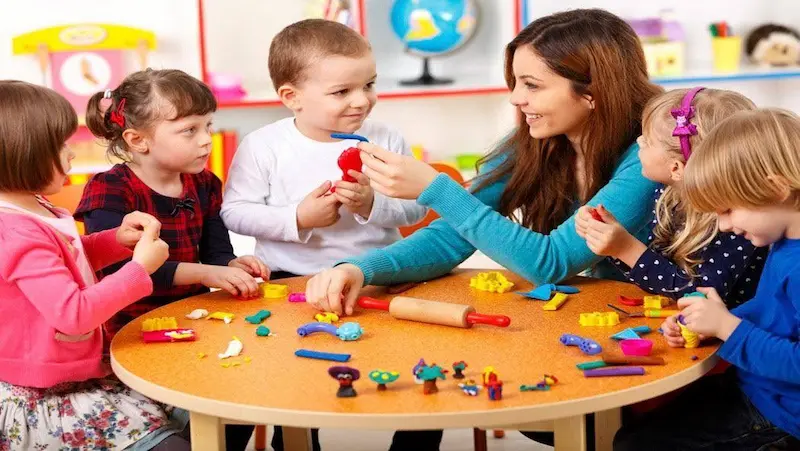Fostering good behavior in children is a critical aspect of their development and growth. As parents, caregivers, and educators, it is our responsibility to guide children in acquiring positive behaviors that will shape their character and contribute to their overall well-being. The significance of encourage good behavior in children extends far beyond their immediate interactions and experiences.
It lays the foundation for their future relationships, achievements, and success in various aspects of life. By nurturing positive behavior, we empower children to become responsible, compassionate, and well-adjusted individuals who can contribute positively to their communities and society as a whole.
This introductory essay will explore the importance of fostering good behavior in children, highlighting the long-term benefits and the role of positive reinforcement, setting clear expectations, and providing consistent guidance in shaping their behavior.
Table of contents
- Setting a Positive Foundation
- Lead by Example:
- Create a Supportive Environment:
- Positive Reinforcement Techniques
- Use of Rewards Systems:
- Encouraging Self-Motivation:
- Effective Communication and Discipline
- Positive Discipline Techniques:
- Establishing Routine and Structure:
- Conclusion:
- Frequently Asked Questions
Setting a Positive Foundation
Establish Clear Expectations for Your Child’s Behavior
As parents, it is natural to want our children to grow up to be well-behaved and responsible individuals. However, achieving this goal requires more than just hope and wishful thinking. Clear expectations play a crucial role in shaping children’s behavior and fostering their overall development.
By establishing age-appropriate expectations and consistently reinforcing them, we can set our children up for success and provide them with a solid foundation for navigating the world. In this blog post, we will delve into the significance of defining expectations, provide tips for setting age-appropriate ones, and highlight the importance of consistency in reinforcing these expectations.

The Significance of Clearly Defined Expectations:
Clear expectations act as guideposts that help children understand what is expected of them in various situations. When children have a clear understanding of the boundaries and rules, they feel more secure and confident.
Defined expectations provide children with a sense of structure and predictability, which contributes to their emotional well-being and reduces anxiety. Furthermore, setting expectations allows parents to teach essential values, social skills, and moral principles, empowering children to make sound decisions as they grow.
Tips for Setting Age-Appropriate Expectations:
Understand Developmental Milestones: It is crucial to consider your child’s age and developmental stage when setting expectations. Younger children may have limited cognitive abilities, while older children can handle more complex tasks. Tailoring expectations to match their abilities ensures they are neither overwhelmed nor bored.
Be Realistic: While it’s essential to challenge children and encourage their growth, setting overly ambitious expectations can lead to frustration and discouragement. Assess your child’s capabilities and set realistic goals that are challenging yet attainable. Gradually raise the bar as your child develops new skills and competencies.
Communicate Clearly: Children rely on clear and consistent communication to understand expectations fully. Use age-appropriate language and simple explanations to convey your expectations. Visual aids, such as charts or illustrations, can be helpful for younger children. Encourage questions and provide clarifications whenever needed.
Involve Your Child: Empower your child by involving them in the expectation-setting process. When children have a voice in establishing rules and boundaries, they are more likely to internalize and follow them. Discuss why certain expectations are important and allow them to contribute their ideas and suggestions.
Click here to know more about robotics programming for kids
The Importance of Consistency in Reinforcing Expectations:
Consistency is key when it comes to reinforcing expectations. Children thrive on routine and predictability, and inconsistency can confuse and undermine their understanding of what is expected. Consistency reinforces the message that expectations are non-negotiable, which helps children develop self-discipline and a sense of responsibility.
Here are a few ways to maintain consistency:
Lead by Example: Children learn by observing their parents and caregivers. Model the behaviors and attitudes you expect from your child. When children see consistent behavior from trusted adults, they are more likely to internalize and emulate those behaviors.
Reinforce Positive Behaviors: Praise and acknowledge your child’s efforts when they meet or exceed expectations. Positive reinforcement strengthens the connection between behavior and reward, motivating children to continue behaving appropriately.
Provide Consequences: Consistently apply appropriate consequences when expectations are not met. Consequences should be reasonable, fair, and proportionate to the misbehavior. This helps children understand the impact of their actions and encourages them to make better choices in the future.
Regularly Review and Adjust: As your child grows and develops, regularly review and adjust expectations to align with their changing abilities and circumstances. Open communication channels with your child and make necessary revisions together.
Lead by Example:
Parenting is an incredibly rewarding yet challenging journey. As parents and caregivers, we have the privilege and responsibility of shaping our children’s behavior and values. One powerful tool at our disposal is leading by example.
By demonstrating positive behavior and values in our own lives, we can have a profound impact on our children’s development. In this blog post, we will explore the influential role of parents and caregivers in modeling good behavior, offer practical advice on leading by example, and discuss the significant impact of consistent positive role modeling on children’s behavior.

Emphasize the influential role of parents and caregivers in modeling good behavior:
As parents, we are our children’s first and most important role models. Children observe our actions, words, and attitudes from a very young age, and they learn by imitating what they see.
Therefore, it’s crucial for us to recognize the influence we have on their behavior and take this responsibility seriously. By embodying the values and behaviors we wish to instill in our children, we can create a positive and nurturing environment for their growth.
Offer practical advice on demonstrating positive behavior and values:
a. Practice open communication: Communicate with your children honestly and respectfully. Show them the importance of expressing thoughts and feelings in a constructive manner.
b. Show empathy and kindness: Demonstrate compassion towards others by engaging in acts of kindness and understanding. Encourage your children to do the same.
c. Display emotional intelligence: Teach your children to recognize and manage their emotions effectively by modeling healthy emotional responses yourself.
d. Prioritize self-care: Show your children the importance of self-care by taking care of your physical, mental, and emotional well-being. This includes setting boundaries and engaging in activities that bring you joy and relaxation.
e. Practice gratitude: Cultivate an attitude of gratitude by expressing appreciation for the things you have and acknowledging the efforts of others. Encourage your children to do the same.
Discuss the impact of consistent positive role modeling on children’s behavior:
Children learn more from what we do than what we say. When we consistently model positive behavior, children internalize these values and are more likely to adopt them as their own. By witnessing kindness, respect, empathy, and other positive qualities in action, children understand their importance and are more inclined to emulate them.
Positive role modeling also helps children develop a strong sense of self-esteem and self-worth, as they see firsthand the impact of their actions on themselves and others.
Consistency is key when it comes to positive role modeling. Children need to see these behaviors consistently in their daily lives to understand their significance. By making a conscious effort to embody the values we want to instill in our children, we create a lasting impact on their behavior and shape them into compassionate, responsible, and empathetic individuals.
Create a Supportive Environment:
The environment in which we live plays a crucial role in shaping our behavior and overall well-being. Both the physical and emotional aspects of our surroundings can significantly impact our moods, attitudes, and actions. This holds true not only for adults but also for children who are particularly sensitive to their environment.
By consciously designing a nurturing and supportive environment, we can create a space that promotes positive behavior and facilitates personal growth. In this blog post, we will explore the influence of the physical and emotional environment on behavior and discuss effective strategies for fostering a supportive environment at home.

The Influence of the Physical and Emotional Environment:
The physical environment encompasses elements such as the layout, organization, and sensory stimuli present in a space. For instance, cluttered and disorganized surroundings can lead to feelings of stress and unease, making it challenging to focus and engage in positive behaviors. On the other hand, a clean, well-structured environment can contribute to a sense of calm and enable individuals to be more productive and content.
Similarly, the emotional environment refers to the atmosphere created through interactions, communication, and relationships within a space. Positive emotional environments characterized by warmth, respect, and open communication tend to foster healthy relationships, self-esteem, and overall well-being. Conversely, environments riddled with conflict, negativity, and tension can have detrimental effects on behavior and emotional development.
Strategies for Creating a Nurturing and Supportive Environment at Home:
a. Cultivate a Positive Atmosphere: Encourage open and honest communication within your household. Create an environment where family members feel safe expressing their thoughts and emotions without fear of judgment or reprisal. Practice active listening and empathy to foster understanding and connection.
b. Establish Clear Boundaries: Clearly define and communicate expectations, rules, and consequences. Consistency is key when it comes to enforcing boundaries, as it provides a sense of structure and security for everyone involved.
c. Encourage Collaboration: Involve family members in decision-making processes, especially when it pertains to shared spaces and routines. By involving everyone, you create a sense of ownership and empowerment, which fosters a supportive environment.
d. Promote Mutual Respect: Teach and model respect within your household. Encourage family members to value each other’s opinions, emotions, and personal space. Celebrate diversity and promote inclusivity, embracing the unique qualities of each individual.
Organizing Spaces and Routines to Promote Positive Behavior:
a. Declutter and Organize: Create an environment free from unnecessary distractions by decluttering and organizing living spaces. Provide designated storage areas for belongings, making it easier for everyone to find what they need and maintain a tidy space.
b. Design Functional Spaces: Consider the specific needs and interests of your family members when designing spaces. Create dedicated areas for different activities, such as a quiet reading nook, a play area, or a workspace. This allows individuals to engage in activities that promote positive behavior and personal growth.
c. Establish Daily Routines: Consistent routines provide a sense of structure and security, particularly for children. Establish a schedule that includes time for essential activities, such as meals, homework, play, and rest. A well-balanced routine helps individuals manage their time effectively, reducing stress and promoting positive behavior.
d. Incorporate Visual Cues: Use visual cues such as charts, calendars, or checklists to aid organization and reinforce positive behavior. These visual reminders can help individuals stay on track, complete tasks, and develop a sense of accomplishment.
Creating a supportive environment at home requires intention, effort, and ongoing commitment. By recognizing the influence of the physical and emotional environment, and implementing strategies for nurturing positive behavior, you can foster a space that promotes personal growth, well-being, and harmonious relationships within your family.
Positive Reinforcement Techniques
In our daily lives, we encounter numerous situations where we interact with others and witness their behavior. Whether it’s in the workplace, at school, or within our personal relationships, positive reinforcement plays a vital role in shaping behavior and fostering a conducive environment.
In this article, we will explore the power of praise and recognition, understand how it can influence behavior, and discuss effective ways to offer genuine praise and incentives.

The Influence of Positive Reinforcement:
Positive reinforcement is a powerful tool that motivates and encourage individuals to repeat desirable behaviors. When we provide praise or recognition for someone’s actions, we reinforce their belief that their efforts are valued and appreciated.
This creates a positive association with the behavior, making it more likely to be repeated in the future. By focusing on positive reinforcement, we can cultivate a culture of growth and improvement while fostering stronger relationships.
Offering Specific and Genuine Praise:
To maximize the impact of praise and recognition, it is important to offer specific and genuine feedback. Vague compliments such as “good job” may lack meaning and fail to provide individuals with actionable information. Instead, try to focus on the specific actions or qualities that impressed you.
For example, instead of saying, “You did great,” you could say, “I really appreciated how you took the initiative to solve that problem. Your resourcefulness and problem-solving skills were impressive.” Such specific praise not only acknowledges the individual’s efforts but also highlights the qualities they can be proud of and continue to develop.
Using Rewards and Incentives:
While praise and recognition are effective on their own, the use of rewards and incentives can further reinforce good behavior. Rewards provide tangible benefits or incentives that motivate individuals to strive for excellence.
These can be in the form of bonuses, promotions, certificates, or even simple acknowledgments like employee of the month awards. By aligning rewards with desired behaviors or goals, organizations and individuals can create a sense of purpose and accomplishment, fostering a culture of continuous improvement.
When implementing rewards, it is essential to ensure they are fair, consistent, and achievable. Setting unrealistic expectations or offering disproportionate rewards may create a sense of discouragement or unfairness. Additionally, rewards should be aligned with long-term objectives, promoting sustained growth and development rather than short-term gains.
Use of Rewards Systems:
In our journey through life, we often find ourselves motivated by rewards. Whether it’s receiving praise for a job well done or treating ourselves to something special after achieving a goal, rewards have a way of boosting our motivation and driving us toward success.
This very concept forms the foundation of reward systems, which are widely used to encourage positive behavior and foster personal growth. In this blog post, we will explore the benefits of reward systems, delve into different types, and provide practical tips for implementing and maintaining them effectively.

Reward Systems: An Overview:
Reward systems are strategies designed to reinforce positive behavior by offering incentives or rewards. These systems can be used in various settings, such as schools, workplaces, and even at home. The underlying principle is to provide tangible or intangible rewards in response to desired behaviors, with the ultimate aim of promoting repetition and establishing positive habits.
Types of Reward Systems:
Sticker Charts: Sticker charts are a popular and visually appealing method used primarily with children. In this system, a chart is displayed, and whenever a desired behavior is exhibited, a sticker or marker is added to the chart. Once a predetermined number of stickers are accumulated, a reward is given to the child. Sticker charts are effective for encouraging consistent positive behavior and can be customized to fit individual needs.
Token Economy: Token economy is a system commonly used in classrooms and therapeutic settings. It involves the use of tokens or points as a form of currency. Participants earn tokens for displaying desired behaviors, and these tokens can later be exchanged for rewards or privileges. Token economies provide a structured framework and can be particularly effective for promoting social skills, academic progress, and self-regulation.
Incentive Programs: Incentive programs are prevalent in workplaces and aim to motivate employees by offering rewards based on performance or achievement. These programs can take various forms, such as bonuses, recognition, or additional time off. Incentive programs help create a positive work environment, boost morale, and foster a sense of accomplishment.
Implementing and Maintaining an Effective Rewards System:
Clearly Define the Desired Behaviors: Before implementing a rewards system, clearly define the behaviors you want to encourage. Be specific about what constitutes a positive behavior, so both the participants and the implementers have a clear understanding.
Select Appropriate Rewards: Choose rewards that are meaningful and appealing to the participants. The rewards should align with their interests, preferences, and developmental stages. For children, rewards can include small toys, books, or special activities. In the workplace, rewards can range from recognition and praise to more tangible incentives.
Establish a Consistent System: Consistency is key to the success of a rewards system. Set clear guidelines for earning rewards, establish a consistent schedule for tracking progress, and communicate the expectations to all participants involved.
Gradually Fade the Rewards: Over time, aim to fade the reward system as positive behaviors become internalized. Once the desired behaviors are consistently exhibited, gradually reduce the frequency or magnitude of rewards while still providing occasional reinforcement. This helps participants develop intrinsic motivation and a sense of personal responsibility.
Celebrate Milestones and Progress: Recognize and celebrate achievements along the way. Acknowledge both small and significant milestones to keep participants motivated and engaged. Publicly acknowledge their efforts, and use positive reinforcement techniques such as praise and encouragement.
Encouraging Self-Motivation:
Self-motivation is a powerful force that drives individuals to achieve their goals and pursue personal growth. Whether it’s learning a new skill, pursuing a passion, or overcoming obstacles, intrinsic motivation plays a crucial role in fostering long-term behavior change. In this article, we will delve into the significance of intrinsic motivation and explore effective strategies to promote self-motivation and self-discipline in children.

The Power of Intrinsic Motivation:
Intrinsic motivation refers to the internal desire and satisfaction one derives from engaging in an activity without relying on external rewards or punishments. It is fueled by curiosity, personal interest, and the inherent enjoyment of the task itself. Unlike extrinsic motivation, which relies on external incentives, intrinsic motivation is sustainable, as it cultivates a genuine love for the activity or goal at hand.
Importance of Intrinsic Motivation:
Sustained Effort: Intrinsic motivation encourage individuals to invest their time and effort willingly. When we genuinely enjoy what we do, we are more likely to persist in the face of challenges and setbacks.
Greater Satisfaction: Intrinsic motivation enhances the sense of accomplishment and fulfillment derived from achieving goals. The process becomes as important as the outcome, leading to greater personal satisfaction and a deeper appreciation of the journey.
Autonomy and Ownership: Intrinsic motivation empowers individuals to take control of their actions, make independent decisions, and develop a sense of autonomy. It nurtures a feeling of ownership, as individuals become active participants in shaping their own lives.
Strategies for Promoting Self-Motivation in Children:
Cultivate Curiosity: Encourage children to explore their interests and passions. Provide them with opportunities to discover new subjects, hobbies, and activities. By nurturing their innate curiosity, you can help them develop a genuine love for learning and personal growth.
Set Meaningful Goals: Involve children in the goal-setting process and guide them in establishing realistic and meaningful objectives. Ensure that the goals align with their interests and values. Breaking down larger goals into smaller, achievable steps helps maintain motivation and provides a sense of progress.
Provide Autonomy: Allow children to have some control over their choices and decisions. Give them the opportunity to make age-appropriate decisions and experience the consequences. This autonomy fosters a sense of responsibility, self-discipline, and intrinsic motivation.
Encourage Mastery and Growth Mindset: Emphasize effort, progress, and improvement rather than focusing solely on outcomes. Teach children the value of embracing challenges, persisting through difficulties, and learning from mistakes. A growth mindset fosters resilience, self-motivation, and a desire for continuous improvement.
Recognize and Celebrate Achievements: Acknowledge and celebrate children’s accomplishments, no matter how small. Positive reinforcement and genuine praise can boost their self-esteem, reinforce intrinsic motivation, and encourage them to continue their efforts.
Foster a Supportive Environment: Create an environment that values self-motivation and personal growth. Encourage open communication, provide constructive feedback, and be an empathetic listener. Supportive and nurturing surroundings play a vital role in promoting self-motivation and intrinsic drive.
Effective Communication and Discipline
Clear and Consistent Communication:
Communication is an essential aspect of human interaction. Whether we’re engaging in personal relationships, professional settings, or even everyday conversations, the way we communicate greatly influences how others perceive us and how our messages are understood.
Clear and consistent communication holds immense power in shaping behavior, fostering understanding, and building meaningful connections. In this blog post, we will delve into the significance of effective communication and explore some valuable tips for achieving clarity in our interactions.

The Significance of Clear and Effective Communication in Shaping Behavior:
Understanding and Empathy: Clear communication promotes understanding, allowing individuals to empathize with each other’s perspectives. When we express ourselves concisely and openly, we bridge gaps in comprehension and encourage a sense of shared understanding. By fostering empathy, clear communication helps shape behavior by fostering positive attitudes, encouraging cooperation, and reducing conflicts.
Influencing Behavior: Effective communication can influence behavior by conveying expectations and establishing boundaries. When expectations are clearly communicated, individuals are more likely to understand what is required of them and act accordingly. Clear communication helps set standards, clarifies goals, and guides individuals toward the desired behavior.
Tips for Using Age-Appropriate Language and Active Listening:
Tailor your language: When communicating with different age groups, it’s crucial to adapt your language to ensure effective comprehension. Use age-appropriate vocabulary, sentence structure, and tone to match the understanding and developmental level of your audience. By doing so, you enhance their engagement, promote active participation, and facilitate effective communication.
Practice active listening: Active listening is a vital skill that allows individuals to fully comprehend and respond appropriately to the messages being conveyed. It involves giving your undivided attention, maintaining eye contact, and being genuinely interested in the speaker’s thoughts and feelings. Active listening not only fosters a deeper connection but also helps avoid misunderstandings, encourage collaboration, and promotes positive behavioral changes.
The Importance of Giving Clear Instructions and Providing Feedback:
Clarity in instructions: Clear instructions leave little room for ambiguity, ensuring that the intended message is understood accurately. When providing instructions, use concise and specific language, break down complex tasks into manageable steps, and offer visual aids if necessary. Clear instructions empower individuals to perform tasks effectively, minimizing confusion, frustration, and errors.
Constructive feedback: Providing clear and constructive feedback is essential for shaping behavior positively. When delivering feedback, be specific about the observed behavior, offer suggestions for improvement, and focus on the action rather than the individual. By providing timely and clear feedback, you encourage growth, motivate individuals to make necessary changes, and strengthen the bond of trust and respect.
Positive Discipline Techniques:
Discipline is an essential aspect of parenting and education, guiding children to develop self-control, responsibility, and respectful behavior. Traditionally, punitive measures like spanking or time-outs have been used to correct misbehavior. However, an alternative approach called positive discipline has gained recognition for its effectiveness in promoting long-term positive outcomes.
By focusing on teaching problem-solving skills and fostering a nurturing environment, positive discipline offers a more constructive approach to guiding children’s behavior. In this blog post, we will explore the principles of positive discipline and discuss techniques such as time-outs, logical consequences, and redirection.

Understanding Positive Discipline:
Positive discipline is a parenting and teaching philosophy based on mutual respect, communication, and cooperation. It aims to teach children appropriate behavior through understanding, guidance, and problem-solving, rather than relying on punishment alone. The foundation of positive discipline lies in building a strong connection with the child and fostering their sense of belonging and significance.
Techniques of Positive Discipline:
a. Time-outs: While time-outs are often associated with punitive discipline, they can also be used effectively in a positive discipline framework. Instead of using time-outs as a punishment, they can serve as a brief break to help children calm down, reflect on their actions, and regain self-control. It is important to communicate the purpose of the time-out clearly and ensure it is not seen as rejection or abandonment.
b. Logical Consequences: Instead of imposing arbitrary punishments, logical consequences help children understand the natural outcomes of their behavior. These consequences are directly related to misbehavior and offer a learning opportunity. For example, if a child refuses to complete their homework, a logical consequence may be not being able to participate in a preferred activity until the homework is done. By connecting the consequence to the behavior, children learn responsibility and understand the impact of their choices.
c. Redirection: Redirecting a child’s behavior involves guiding them toward a more appropriate alternative when they engage in undesirable actions. For instance, if a child is throwing toys, instead of scolding them, redirect their attention to an engaging activity or provide a suitable object for throwing, like a softball. This technique helps children understand boundaries and encourages them to make positive choices.
Teaching Problem-Solving Skills:
One of the critical aspects of positive discipline is teaching children problem-solving skills. Instead of imposing solutions, encourage children to brainstorm ideas and consider the consequences of their actions. This approach empowers them to think critically, make informed decisions, and take responsibility for their behavior. By involving children in problem-solving, we equip them with valuable life skills that promote independence, creativity, and resilience.
Establishing Routine and Structure:
In the hustle and bustle of daily life, establishing routine and structure may seem mundane or unnecessary. However, when it comes to promoting positive behavior in children, routine and structure play a vital role.
These elements provide a sense of security, stability, and predictability, enabling children to develop self-discipline, emotional regulation, and a strong foundation for healthy growth. In this blog post, we will delve into the benefits of routine and structure, provide guidance on establishing daily routines and consistent expectations, and offer suggestions for involving children in the creation of their routines.

The Benefits of Routine and Structure:
Emotional Security: Children thrive when they know what to expect. A well-structured routine instills a sense of emotional security, reducing anxiety and promoting a sense of calmness.
Consistency and Predictability: Regular routines establish a reliable framework for children to follow. Predictability helps them understand expectations, reduces resistance to transitions, and fosters a sense of control over their environment.
Improved Time Management Skills: A structured routine teaches children the value of time and aids in the development of time management skills. It enables them to prioritize tasks, understand the consequences of procrastination, and learn to allocate time efficiently.
Enhanced Self-Discipline: Engaging in a routine teaches children the importance of self-discipline. By consistently adhering to expectations and engaging in activities at specific times, they learn to regulate their behavior and develop the ability to delay gratification.
Guidance on Establishing Daily Routines and Consistent Expectations:
Consistency is Key: Establish consistent expectations for daily routines. This includes consistent wake-up and bedtimes, meal times, homework schedules, and playtime. Consistency reinforces the idea that certain activities should occur at specific times.
Age-Appropriate Tasks: Tailor routines to your child’s age and developmental stage. Younger children may require more guidance and supervision, while older children can take on greater responsibilities and have more autonomy in their routines.
Flexibility within Structure: While routines provide structure, it is essential to allow some flexibility to accommodate unexpected events or special occasions. This teaches children that adaptability is crucial and helps prevent rigid thinking.
Positive Reinforcement: Acknowledge and praise your child’s efforts in following the routine. Positive reinforcement motivates children and helps them internalize the benefits of adhering to the established structure.
Suggestions for Involving Children in the Creation of Routines:
Discuss and Explain: Involve children in conversations about routines and their benefits. Explain the reasons behind specific expectations and how they contribute to their overall well-being. This fosters a sense of ownership and understanding.
Collaborative Decision-Making: Encourage children to contribute their ideas and preferences when creating the routine. Offer choices within reasonable boundaries, allowing them to feel a sense of control over their daily activities.
Visual Aids: Use visual aids such as charts, checklists, or colorful calendars to make routines more engaging and easily understandable for younger children. Visual representations help them grasp the sequence of tasks and reinforce the structure.
Regular Reviews and Adjustments: Periodically review and adjust the routine together with your child. As they grow older or encounter new interests, their needs may change. By involving them in these discussions, you demonstrate that routines can evolve and adapt to their changing circumstances.

Also, you have to know about the concept of python coding for kids
Conclusion:
In conclusion, implementing the strategies discussed in this guide is a valuable step toward fostering a healthy and harmonious family environment. However, it is important to recognize that every family is unique, with its own dynamics, challenges, and strengths. Encouraging readers to implement these strategies gradually and adapting them to their specific family dynamics is essential for long-term success.
Furthermore, adapting these strategies to fit the specific dynamics of each family is crucial. What works for one family may not work for another, as each family has its own unique needs, values, and communication styles. It is important to consider factors such as the age and interests of family members, work schedules, and individual preferences when implementing these strategies.
Additionally, ongoing evaluation and flexibility are key. As families progress on their journey towards a healthier and more harmonious dynamic, they should continuously assess what is working well and what needs adjustment. The needs of a family may evolve over time, so being open to adapting and refining the strategies accordingly is vital.
In summary, the implementation of strategies discussed in this guide can bring about positive changes in family dynamics. Encouraging readers to take a gradual approach and adapt these strategies to their specific family dynamics will increase the likelihood of success. By doing so, families can create a nurturing and supportive environment that promotes growth, happiness, and resilience for all its members.
Also, BrightChamps provides a comprehensive platform for learning about money for kids, offering interactive and engaging resources that teach financial literacy, budgeting, saving, and other essential money management skills.
Frequently Asked Questions
A1. Encouraging good behavior in kids promotes social development, and positive relationships, and builds a foundation for responsible and respectful adulthood.
A2. Positive reinforcement, setting clear expectations, using praise and rewards, and modeling good behavior are effective strategies to encourage good behavior in kids.
A3. Positive reinforcement involves rewarding and acknowledging good behavior, which encourages its repetition and strengthens desired behaviors in kids.
A4. Techniques such as using consistent discipline, offering choices, using time-outs or logical consequences, and using effective communication can help parents encourage good behavior in kids.
A5. Setting clear expectations and boundaries provides children with a framework for understanding acceptable behavior, promoting consistency and clarity in their actions.
A6. Consistent discipline provides structure and teaches children about consequences, helping them understand the difference between right and wrong and promoting consistent good behavior.
A7. Parents can effectively communicate their expectations to their children by using clear and concise language, active listening, positive reinforcement, and setting realistic and age-appropriate expectations.
A8. Strategies like positive reinforcement, consistent discipline, clear expectations, and fostering a supportive and respectful environment can be implemented in various settings to encourage good behavior in kids.
A9. Parents can handle challenging behaviors by using calm and consistent discipline, focusing on positive alternatives, teaching problem-solving skills, and seeking support or guidance when needed.


 We are an army of educators and passionate learners from BrightChamps family, committed to providing free learning resources to kids, parents & students.
We are an army of educators and passionate learners from BrightChamps family, committed to providing free learning resources to kids, parents & students.







